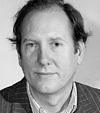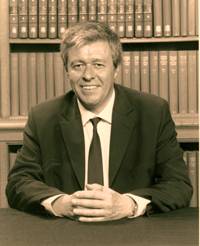
Invited Speakers
The conference will have a set of distinguished speakers delivering talks on exciting new frontiers. The list of speakers below is incomplete and will be finished soon.
Banquet Talk: Colin Howson
(University of Toronto)

Separation - and Reconciliation?
Leibniz called probability a new kind of logic, though afterwards opinions wavered as to whether he was right. By the fourth decade of the twentieth century there finally seemed little further room for doubt: he wasn't. The methods and tools of both logic and probability had been re-forged in a way that that made it clear to most people that the two were completely disjoint disciplines. The title logic got restricted to theories whose formal structure overlapped sufficiently that of first order logic, and probability theory for most workers became in effect measure theory. But the second half of the twentieth century and the beginning of the twenty-first has seen a renewed interest in a logical interpretation, or more accurately interpretations, of probability.
Biographical detailsColin Howson was Professor of Philosophy at the London School of Economics (LSE), UK, until moving to the University of Toronto in 2008. He started his career as a temporary lecturer at LSE in 1968, as a colleague of the eminent philosopher (Sir) Karl Popper. He never accepted Popper's well-known rejection of subjective probability, and subsequently became an advocate of the Bayesian theory. He has published three books, in the areas of probability and logic: Scientific Reasoning: the Bayesian Approach (with Peter Urbach), now in a third edition, Logic With Trees, and Hume's Problem: Induction and the Foundations of Belief. A fourth book, Objecting to God, is in press. He is a past-President of the British Society for the Philosophy of Science and is married to fellow-philosopher Margaret Morrison.
Speaker July 15: James M. Rehg
(Georgia Institute of Technology)

Behavior Imaging and the Study of Autism
Beginning in infancy, individuals acquire the social and communication skills that are vital for a healthy and productive life. Children with developmental delays face great challenges in acquiring these skills, resulting in substantial lifetime risks. Children with an Autism Spectrum Disorder (ASD) represent a particularly significant risk category, due both to the increasing rate of diagnosis of ASD and its consequences. Since the genetic basis for ASD is unclear, the diagnosis, treatment, and study of the disorder depends fundamentally on the observation of behavior. Unfortunately, current methods for acquiring and analyzing behavioral data are so labor-intensive as to preclude their large scale application. In this talk, I will describe our research agenda in Behavior Imaging, which targets the capture, modeling, and analysis of social and communicative behaviors between children and their caregivers and peers. We are developing computational methods and statistical models for the analysis of vision, audio, and wearable sensor data. Our goal is to develop a new set of capabilities for the large-scale collection and interpretation of behavioral data. I will describe several research challenges in statistical modeling which arise in this area, and present illustrative results in the video-based analysis of social interactions.
Biographical detailsJames M. Rehg (pronounced "ray") is a Professor in the School of Interactive Computing at the Georgia Institute of Technology, where he is the Director of the Center for Behavior Imaging, co-Director of the Computational Perception Lab, and Associate Director of Research in the Center for Robotics and Intelligent Machines. He received his Ph.D. from CMU in 1995 and worked at the Cambridge Research Lab of DEC (and then Compaq) from 1995-2001, where he managed the computer vision research group. He received the National Science Foundation (NSF) CAREER award in 2001, and the Raytheon Faculty Fellowship from Georgia Tech in 2005. He and his students have received a number of best paper awards, including best student paper awards at ICML 2005 and BMVC 2010. Dr. Rehg is active in the organizing committees of the major conferences in computer vision, most-recently serving as the General co-Chair for IEEE CVPR 2009. He has served on the Editorial Board of the International Journal of Computer Vision since 2004. He has authored more than 100 peer-reviewed scientific papers and holds 23 issued US patents. Dr. Rehg is currently leading a multi-institution effort to develop the science and technology of Behavior Imaging, funded by an NSF Expedition award (see www.cbs.gatech.edu for details).
Speaker July 16: Hod Lipson
(Cornell University)

Scientific Data Mining: Distilling Free-Form Natural Laws from Experimental Data
For centuries, scientists have attempted to identify and document analytical laws that underlie physical phenomena in nature. Despite the prevalence of computing power, the process of finding natural laws and their corresponding equations has resisted automation. A key challenge to finding analytic relations automatically is defining algorithmically what makes a correlation in observed data important and insightful. We will show that by seeking dynamical invariants, we can go from finding just predictive models to finding deeper conservation laws. Applications to modeling physical and biological systems will be shown, and both deterministic and stochastic models will be considered.
Biographical detailsHod Lipson is an Associate Professor of Mechanical & Aerospace Engineering and Computing & Information Science at Cornell University in Ithaca, NY. He directs the Creative Machines Lab, which focuses on novel ways for automatic design, fabrication and adaptation of virtual and physical machines. He has led work in areas such as self-modeling systems, evolutionary robotics, 3D printing, machine self-replication and programmable self-assembly. Lipson received his Ph.D. from the Technion - Israel Institute of Technology in 1998, and continued to a postdoc at Brandeis University and MIT. His research focuses primarily on biologically-inspired approaches, as they bring new ideas to engineering and new engineering insights into biology. For more information visit http://www.mae.cornell.edu/lipson.
Speaker July 17: Karl Friston
(Wellcome Trust Centre for Neuroimaging,
University College London)

Active Inference and Uncertainty
In this presentation, I will rehearse the free-energy formulation of action and perception, with a special focus on the representation of uncertainty: The free-energy principle is based upon the notion that both action and perception are trying to minimise the surprise (prediction error) associated with sensory input. In this scheme, perception is the process of optimising sensory predictions by adjusting internal brain states and connections; while action is regarded as an adaptive sampling of sensory input to ensure it conforms to perceptual predictions (this is known as active inference). Both action and perception rest on an optimum representation of uncertainty, which corresponds to the precision of prediction error. Neurobiologically, this may be encoded by the postsynaptic gain of prediction error units. I hope to illustrate the plausibility of this framework using simple simulations of cued, sequential, movements. Crucially, the predictions driving movements are based upon a hierarchical generative model that infers the context in which movements are made. This means that we can temporarily confuse agents by changing the context (order) in which cues are presented. These simulations provide a (Bayes-optimal) simulation of contextual uncertainty and set-switching that can be characterised in terms of behaviour and electrophysiological responses. Interestingly, one can lesion the encoding of precision (postsynaptic gain) to produce pathological behaviours that are reminiscent of those seen in Parkinson's disease. I will use this as a toy example of how information theoretic approaches to uncertainty may help understand action selection and set-switching.
Biographical detailsKarl Friston is a neuroscientist and authority on brain imaging. He invented statistical parametric mapping; SPM is an international standard for analysing imaging data and rests on the general linear model and random field theory (developed with Keith Worsley). In 1994, his group developed voxel-based morphometry. VBM detects differences in neuroanatomy and is used clinically and as a surrogate in genetic studies. These technical contributions were motivated by schizophrenia research and theoretical studies of value-learning (with Gerry Edelman). In 1995 this work was formulated as the disconnection hypothesis of schizophrenia (with Chris Frith). In 2003, he invented dynamic causal modelling (DCM), which is used to infer the architecture of distributed systems like the brain. Mathematical contributions include variational filtering and dynamic expectation maximization (DEM) for Bayesian model inversion and time-series analysis. Friston currently works on models of functional integration in the human brain and the principles that underlie neuronal interactions. His main contribution to theoretical neurobiology is a free-energy principle for action and perception. Friston received the first Young Investigators Award in Human Brain Mapping (1996) and was elected a Fellow of the Academy of Medical Sciences (1999) in recognition of contributions to the bio-medical sciences. In 2000 he was President of the international Organization of Human Brain Mapping. In 2003 he was awarded the Minerva Golden Brain Award and was elected a Fellow of the Royal Society in 2006.